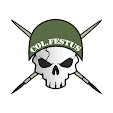Hey guys, here to give you some insight into painting Retribution of Scyrah myrmidons!
So many people see the studio scheme for Retribution and cringe in horror at the thought of painting all that white. Well I wanted to try and make the process a bit easier as I really enjoy their studio scheme. I wanted to try out my oil techniques for weathering but apply it for the green glowing effects Retribution is known for.
First off I started the model by basing it, then undercoating it with a grey primer. The grey is a great way to start white and I highly recommend it. Also a quick tip here, I usually base all my models with liquid super glue and paver’s base. I use a bent toothpick to move the glue around into all the cracks and nooks. I then simply dunk it in a small thing of paver’s bases. After that I undercoat the model. This further reinforces the basing job and in the end you have an extremely tough basing, which doesn’t rub or flake off.
So after the model was dry (using my fridge technique from my last post) I set about working on the whites. I figured the only way to go here was with an airbrush. I busted out my HP-B Iwata and went to town. I started by using a new color by Vallejo called Ivory. I thinned it down using a new thinner I’ve been using. Its 1:10 mix of Liquitex flow-aid to distilled water. I usually mix the paint until it has the consistency of milk. I took this and put a solid base coat on the entire miniature. The great part about Retribution myrmidons is that all the cracks on them are supposed to admit a green glow. With the oil painting technique I’ll talk about later you can get away with leaving no shading in the lines of the model.
Once the basecoat was complete I moved onto pure white. I took Model Air: white and gave the model a few coats from the top down. Leaving the undersides facing the base Ivory.
Now comes the labor-intensive part. I took Chainmail and carefully painted all the metal components. Once those were dry I washed all the metal areas but the sword with Badab Black. The areas of metal destined to be turquoise got a 1:1 mix of Asurman Blue to Thrakka Green. I then dry brushed a coat of Chainmail over the turquoise metal area. I then sealed the entire model with Pledge: Future Floor wax.
Now for the fun part! I headed down to a local craft store and snooped around for an oil paint that I felt would accurately recreate the green glow of the studio scheme. Using the same techniques outlined in my weathering
tutorial I applied a liberal wash to the cracks and crevices of the model. It was thinned down using W&N mineral spirits. Two things to remember here: oil paints take a long time to dry, the best results from this technique will happen when you let oil paints dry! The process can be sped along with a heat gun. Just be aware that you are working with plastic miniatures. Once the oil paint was dry I took a clean brush and began to blend it into the model in circular strokes. The result was even better than I hoped. At first there was too much green but this is easily solved by taking a clean Q-tip and wiping off excess paint thanks to the coat of Future Floor Wax.
Once I finished the blending I applied another layer of Future.
Then I used Liquitex Matte Varnish cut 1:1 with my blend of flow-aid from earlier applied with my airbrush. Once that was dry I hit the entire model with Testors: Dullcote. Here is the finished product!
~Overall I’m extremely happy with the outcome of this myrmidon. It took me about 3 hours to paint and no major headaches. To note I did try this technique on infantry and wasn’t happy with the result. The models were too small to effectively blend the oil paints. Anyway I hope you enjoyed! As always any questions feel free to email me at col.festus@gmail.com!
